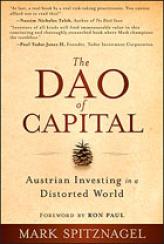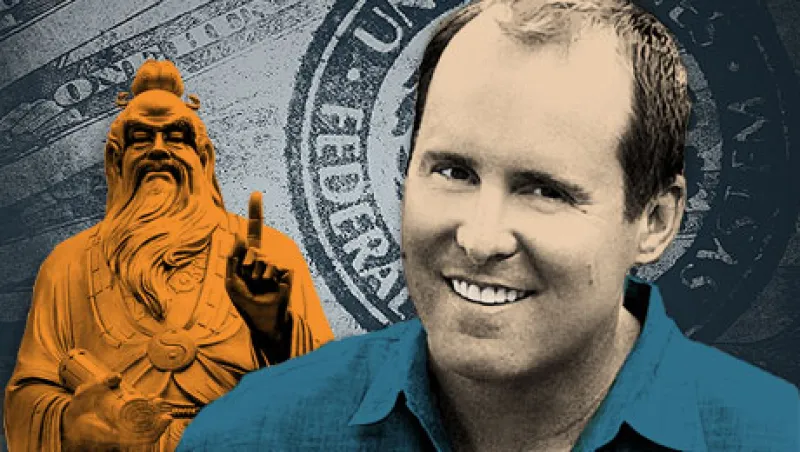As founder and president of Universa Investments in Santa Monica, California, Mark Spitznagel runs a hedge fund designed to make money during so-called black swan events — rare and unexpected occurrences that cause shocks in financial markets. Universa’s flagship fund loses small amounts of capital most months, but the financial crisis sent its returns soaring by 120 percent in 2008. Even so, Spitznagel says he has never seen a black swan attack the financial markets.
“When it comes to market events, there have been no impactful black swans — the so-called unexpected ‘tail events,’ ” he writes in the introduction to his new book, The Dao of Capital: Austrian Investing in a Distorted World. “What were unseen by most were, indeed, highly foreseeable.”
The U.S. Federal Reserve planted the seeds for the last financial crisis with interest rate intervention, according to Spitznagel. The intervention goes back to the dot-com crash, when the Fed brought interest rates down and set U.S. investors scurrying into real estate. “Weird things happen when interest rates don’t reflect what’s going on in the real world,” Spitznagel tells Institutional Investor. He believes the U.S. stock markets will plunge again, as quantitative easing unwinds.
In The Dao of Capital, Spitznagel steps back much further in history to explain how he believes the financial system should work — to the 6th century B.C. The ancient Chinese philosophy known as the Dao De Jing (or Tao Te Ching) has much to teach us, Spitznagel says, about the value of noncoercive action in gaining a winning hand, whether as an investor or a sage. He compares investment strategies to the military strategies laid out in the ancient Chinese treatise known as The Art of War, attributed to Sun Tze, which stresses the importance of gaining influence through nonintervention and nondeployment.
As the title suggests, Spitznagel also brings in his studies of the Austrian School of economics, which advocates achieving profits through a roundabout means, defined as “going right in order to then go left.” The quintessential role model for roundabout capitalism, he says, was Henry Ford. “Rather than going directly for profits,” says Spitznagel, “he was focused on the means to those profits and developing the capital structure in a way that would build tools for future productivity.”
Spitznagel believes that financial markets function best when the government leaves them alone. If Federal Reserve chairman Ben Bernanke had allowed interest rates to follow the natural course of events, he says, “the stock market plunge would have been deeper but I think we’d be on the way to real economic recovery.”
In an exclusive excerpt below from The Dao of Capital, Spitznagel looks at the wilderness as a perfect stand-in for Wall Street. If the government were to let industries and institutions fail, he argues, new entities would have the space to bloom. That’s how life operates in the forest, where small, spontaneous brushfires clear away unhealthy vegetation, allowing the timberland to regenerate and preventing it from drying out to the point that a devastating fire ignites. Small fires are a way of preventing disasters like the Yellowstone National Park fire of 1988. Spitznagel believes that, in a similar fashion, if there were no monetary intervention, there would be fewer crises that led politicians to call for intervention or bailouts.
“When you prevent the natural balancing act, you get growth that shouldn’t be happening,” says Spitznagel. “The huge ebbing and flowing of business cycles that we see now is not a natural feature of financial markets.” Without intervention, he adds, “we might have less severe cycles based on creative destruction, with new inventions replacing old ones.” — Jan Alexander
The Danger of Artificial Changes
Excerpt from Chapters 2 and 8

|
Nature takes a roundabout, intertemporal approach; indeed, this strategy is the conifers’ singular advantage over the more aggressive angiosperms.
The conifers can leave the more tangible and immediate gains from the fertile, sun-drenched areas to the angiosperms and retreat (thanks to their wind-borne seeds) to the rocky, exposed areas where conditions are harsh but sunlight is still plentiful. It is not that conifers prefer rocky, acidic, sandy, waterlogged, and other low-quality soils; indeed, when they are planted and cultivated in better climates with more fertile conditions, conifers thrive. However, in order to avoid the direct competition for scarce resources, conifers retreat to inferior soil, wind-battered ridges, and low-lying areas where water collects, leaving the prime site to the faster growers.
The story, however, does not end there. It does not matter where one tree grows or what happens with one pinecone, which is all that we can see. Rather, we focus on what none can see: a roundabout strategy unfolding intertemporally in the forest, through the reallocation of scarce available resources. Conifers are soft, highly flammable, highly fragile, but in their roundabout intertemporal strategy — in gaining by losing — they are strong. Here, again, we see our two-step process, a strategy of intermediate objectives attained by a group of individual trees in pursuit of an edge, an eventual gain for the species.
To observe and appreciate the homeostatic nature of the market (the market that, as the great Austrian School economist Ludwig von Mises reminded us, is a process), we must shift our perception and stop thinking of systems as being driven only as a hapless victim of random shocks (such as lightning strikes that start fires) and instead embrace the reality of the system as adapting to those shocks in an ongoing discovery process.
A forest fire turns especially deadly when smaller blazes are suppressed, creating the illusion of fire protection. Admittedly, fire is a complex subject in forestry; on one hand, it would seem to make intuitive sense that forest preservation would mean limiting, controlling, or outright prevention of fires that kill trees. At the risk of oversimplification, however, such thinking has proved to be a li strategy (to use the Daoist term for the direct, head-on approach) focused on the direct means of today’s trees and keeping the forest status quo at all costs. The roundabout shi strategy (which focuses first on the intermediate, as the means to the ultimate end) is the willingness to pursue — or, more specifically in this case, allow — an intermediate objective of naturally occurring fires that do destroy trees (and some healthy specimens right along with the unhealthy ones) now, in order for a succession of forest growth to emerge intertemporally. Between conifers and angiosperms in particular, the ecosystem must always discover the right balance, which changes and adapts to climate and other environmental shifts.
Fire is a natural, dynamic force of change like any other predator whose presence is crucial to maintaining the health of other species (just as rabbits would overrun and destroy the meadow and ultimately starve themselves were it not for the foxes that hunt them). When a population within an ecosystem exceeds the amount of resources present (too many rabbits in the meadow), it must be controlled by predator-consumers (the foxes, which do not have to try very hard to capture their next meal). And when the system reaches balance (just the right number of rabbits), the predator-consumers are also managed; they go hungry or move elsewhere. In the case of the overgrown forest, control most often comes from the most ravenous and indiscriminate of all herbivorous predators — fire, which thus becomes the consumer that most often accomplishes the control function. Smaller, low-intensity fires manage the forest with great expediency, reducing density by clearing underbrush — including the stunted and spindly conifers that cannot compete with larger angiosperms — while leaving the canopy growth untouched.
Paradoxical, yes, but forestry practices of old that have regained respect of late underscore the importance of letting small fires burn in order to manage the forest and prevent the bigger ones that inevitably and cruelly result from attempts to stop fire. Suppression now undeniably leads to greater destruction later on — once again. our “bad economists.”
Nowhere in the history of forestry was that evil more savagely felt than in Yellowstone National Park in 1988, when nearly 800,000 acres — well over one third of the park — burned or suffered fire damage. It was a catastrophe of unprecedented proportion in the history of the National Park Service, and its root cause was fire suppression.
The spread of fire-suppression mentality can be linked to the establishment of forest management in the United States, such that by the early 1900s, forests became viewed as resources that needed to be protected — in other words, burning was no longer allowed. The danger in this approach became tragically apparent in Yellowstone, which was recognized by the late 1980s as being overdue for fire; yet smaller blazes were not allowed to burn because of what were perceived to be risks that were too high, given the dry conditions. And so smaller fires were put out but, in the end, could not be controlled and converged into the largest conflagration in the history of Yellowstone. Not only did the fire wipe out more than 30 times the acreage of any previously recorded fire; it also destroyed summer and winter grazing grounds for elk and bison herds, further altering the ecosystem. Because of fire suppression, the trees had no opportunity or reason to ever replace each other, and the forest thus grew feeble and prone to destruction. A lattice of unwarranted and anemic growth (what was ill-seeded from the start and never had a chance of reaching maturity) became a grid that linked and transmitted the costs of the forest’s distortion to a much wider area than would have been affected by a series of natural, smaller fires over the years. It was the Yellowstone effect.
The disastrous Yellowstone fire of 1988 leads to the conclusion that 100 years of fire suppression — a zero-tolerance approach to stamp out even naturally occurring, low-intensity blazes — had made the forest dangerously prone to catastrophe. From a forestry point of view, the lessons have been learned. In 1995, the Federal Wildland Fire Management policy recognized wildfire as a crucial natural process and called for it to be reintroduced into the ecosystem.
As I observed in a 2011 piece in the Wall Street Journal, central bankers, too, could learn a thing or two from their forestry brethren. The federal government has another “fire suppression policy” that started, coincidentally, just a few years before the Yellowstone blaze, with the 1984 Continental Illinois “too big to fail” bank bailout. This was followed by Alan Greenspan’s pronouncement immediately after the 1987 stock market crash that the Federal Reserve stood by with liquidity to support the economy and the financial system. In its actions in the 1980s, the Federal Reserve telegraphed to the world that it would no longer tolerate fires of any size — which heralded the birth of the “Greenspan put.”
In the financial forests of our own making, suppression is particularly problematic — and even deadly. Excess and malinvestment thrive for a time, only to be destroyed by ravages caused by their own vulnerability. Yet, as we will see, even such high-intensity “fires” (of the forest and financial varieties) will free up and redistribute resources; in the case of the market, it releases capital to areas previously avoided due to the myopic distortions of monetary intervention. (The Austrian School naturally understood this well, as explained by the Austrian Business Cycle Theory.)
Central bankers and interventionists need to stop approaching the system as one driven by random shocks, because this mind-set leads them to manipulate and attempt to control the system — a cycle that destroys far more in the long run than it saves temporarily. The longer their erroneous thinking persists, the more out of balance things become, until there is a tinderbox of malinvestment ready to ignite in a massive, uncontrollable inferno. Density (overgrowth) and uniformity (too much of one thing, namely, immediate-returning or high-yielding capital, as opposed to the more roundabout variety, grown in the economy and “fertilized” by distortion) are the evidence of malinvestment in the economy, exceeding the amount of available resources. Investment cannot exceed savings any more than seeding in the forest can exceed land, nutrients, water, and sunlight — but under these interventions, the system acts as if that’s what is happening. This is what makes the boom so delusive and ultimately illusory.
Here, we encounter the profound paradox that government interventions systematically achieve the very opposite of their intended goals.
So governments, unlike entrepreneurs, try as they might and despite perhaps good intentions (I’ll give the Paul Krugmans of the world the benefit of the doubt), simply cannot achieve their intended outcomes by interfering with the operation of the system. (They cannot act teleologically, as it were.) Governments and central banks undermine the natural homeostatic process by short-circuiting the governors and adaptive teleological processes in the system.
Suppression of the market’s natural homeostatic tendencies — such as by proclaiming things to be “too big to fail” or by cutting interest rates when the stock market takes a dive — only makes things worse by artificially propping up assets that should be allowed to fail and free up resources for another, perhaps more productive attempt. (A perfect example is the Troubled Asset Relief Program of 2008, or TARP, a completely unnecessary action by the U.S. government to buy equity stakes and underwater assets from financial institutions as a response to the crisis that, like a wildfire, was trying to correct the artificial distortions in the system. Rather than precluding a catastrophic event, TARP precluded rational market adjustments.) Suppression makes the cure that much worse than the initial ill, until exponentially more damage is done, calling to mind the wry observation of Mises: “If a man has been hurt by being run over by an automobile, it is no remedy to let the car go back over him in the [opposite] direction.”
Blaming wild market volatility on the “animal spirits” of the herd mentality takes the focus off where it belongs: on the actions of the government. Instead of functioning as instruments of information, signaling to entrepreneurs how and when best to serve consumers, interest rates are perpetually manipulated by central bank actions to the point of meaninglessness. Artificial changes in interest rates become a deceptive feint by which entrepreneurs succumb to malinvestment, because they believe there are more resources (that is, savings) in the system than there really are. Monetary policy insidiously plays with our time preferences (whether we want to save now in order to spend later or are most interested in consuming now) and our very ability to engage in economic calculation. The greater the distortion, the greater destruction needed to correct it.
The financial crisis of 2008 could have been the wake-up call that, like the Yellowstone fires of 1988, alerted so-called managers to the dangers of trying to override the natural governors of the system. Instead, the Federal Reserve, with its head “ranger,” Ben Bernanke, has deluded itself into thinking it has tamped down every little smolder from becoming a destructive blaze, but instead all it has done is poured the unnatural fertilizer of liquidity onto a morass of overgrown malinvestment, making it even more highly flammable. One day — likely sooner than later, it will burn, and when that happens, the Fed will be sorely lacking in buckets and shovels and must succumb to the flames.
Excerpted from The Dao of Capital, by Mark Spitznagel, with permission from the publisher, Wiley. Copyright © 2013.






